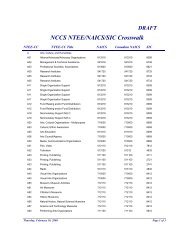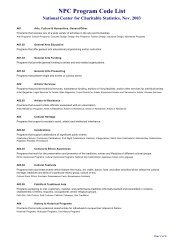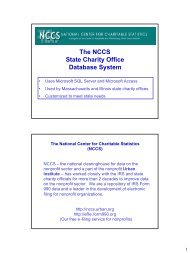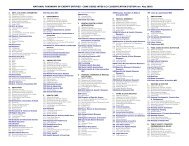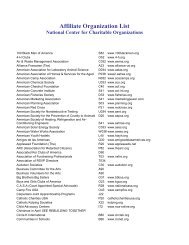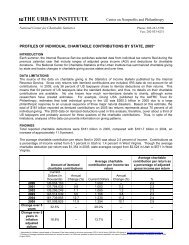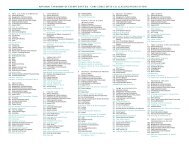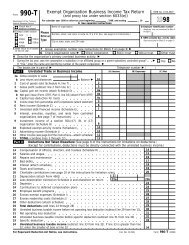Using Urban Institute Data Tools - National Center for Charitable ...
Using Urban Institute Data Tools - National Center for Charitable ...
Using Urban Institute Data Tools - National Center for Charitable ...
Create successful ePaper yourself
Turn your PDF publications into a flip-book with our unique Google optimized e-Paper software.
<strong>Using</strong> <strong>Urban</strong> <strong>Institute</strong> <strong>Data</strong> <strong>Tools</strong><br />
Tom Pollak<br />
Program Director<br />
<strong>National</strong> <strong>Center</strong> <strong>for</strong> <strong>Charitable</strong> Statistics<br />
at the <strong>Urban</strong> <strong>Institute</strong><br />
American Humanics Management/Leadership <strong>Institute</strong><br />
January 5, 2009
Introduction<br />
• NCCS is repository of IRS data on nonprofit<br />
organizations; regular research reports, Almanac on<br />
dimensions of sector<br />
• NCCS created 1981; later, part of Independent Sector’s<br />
research division<br />
• Moved to <strong>Urban</strong> <strong>Institute</strong> in 1996 – Nonpartisan<br />
economic & social policy research organization, 10<br />
policy centers, 350 staff<br />
• NCCS is part of <strong>Urban</strong>’s <strong>Center</strong> on Nonprofits and<br />
Philanthropy<br />
2
Building the Nonprofit <strong>Data</strong><br />
Infrastructure<br />
• Collecting & standardizing IRS data; helping<br />
practitioners work with in<strong>for</strong>mation<br />
•- 990 Online - completing your 990 & 990-N<br />
- Outcome measurement tools<br />
•- Fundraising Effectiveness Project<br />
• Providing guides and resources to make the data<br />
accessible to researchers, policymakers &<br />
practitioners<br />
• KnowledgeBase & FAQs<br />
• Statistics and data online<br />
3
Research & Statistics<br />
• Nonprofit Almanac 2008<br />
Two earlier versions in collaboration with<br />
Independent Sector.<br />
• Overhead Cost Study: 990 analysis, 1,500<br />
respondent survey & case studies<br />
• Other analyses <strong>for</strong> Giving USA, international<br />
development orgs, press queries, policy-makers<br />
– Supporting organizations<br />
– Advocacy organizations<br />
– Arts organizations<br />
4
Nonprofit Organizations<br />
• 2.3 million organizations in our Master List of<br />
Nonprofit Organizations (1989-present)<br />
• All “registered” tax exempt organizations -- Business<br />
Master Files from IRS -- 1.5 mil. (Dec. 2008)<br />
• IRS Forms 990/990-PF filers in 2006<br />
– 327,000 - public charities<br />
– 88,000 - private foundations<br />
– 129,000 - other exempt organizations<br />
5
1995 – 2005: Overview<br />
• 42% of public charities filing 990s in 2005 are new<br />
since 1995<br />
• 23% that filed in 1995 no longer file<br />
• Result:<br />
Steady 5% net growth in number of public charities<br />
filing IRS Form 990s<br />
6
1995 – 2005: Finances<br />
Public Charities<br />
• Total revenue grew by<br />
95% (current $)<br />
• Earned “program service<br />
revenue” grew by 89%<br />
• Gov't grants by 118%<br />
• Private contribs. by 132%<br />
• Total assets 105%<br />
• Net assets 137%<br />
US Economy & Popul.<br />
• Inflation 28%<br />
• GDP growth (current $)<br />
68%<br />
• Population 11%<br />
• NY Stock Exchange<br />
Composite 122%<br />
7
1995 to 2005: Individual Orgs<br />
• 166,000 non-supporting public charities in 1995<br />
• “Died”<br />
– No longer registered: 11.7%<br />
– No longer filing a 990: 11.1%<br />
• Shrinking or stagnant<br />
– Expenses less than 80% of 1995 level: 8.9%<br />
– Expenses 80 – 128%: 15.5%<br />
• Slight to moderate growth 128 – 200%: 23.8%<br />
• Strong growth 200 – 400%: 19.9%<br />
• “Nonprofit Googles” (400+%): 9.2%<br />
• Bottom lines:<br />
• 23% failed, 24% stagnant or shrinking<br />
8
Does One Size Fit All?<br />
• Different size organizations<br />
• Different fields or industries have different<br />
financial and programmatic dynamics<br />
– Steady base of funding<br />
– Many small funders, sales<br />
– Dependent on a few major funders<br />
• Program dynamics<br />
– Widgets vs. “one-offs”<br />
– Human resource challenges: volunteer vs.<br />
staffed<br />
9
Other Frameworks<br />
• Service delivery – traditional health and human<br />
service<br />
• Entrepreneurial – social entrepreneur's grand<br />
idea<br />
• Community-based – PTAs, congregations<br />
• Expressive – artistic, faith-based<br />
• Advocacy & social change<br />
– Also see Frumkin; Milofsky (unpublished)<br />
10
Different Funding Strategies<br />
% of Public Charities That Receive At Least 80% of Revenue<br />
from One Source<br />
Government Grants 8.3%<br />
Private Contributions 23.2%<br />
Program Service Revenue 23.2%<br />
Investments 3.5%<br />
Diverse funding sources 41.8%<br />
11
Improving <strong>Data</strong> Quality<br />
• Electronic Filing of 990s – 15,000 returns created – and state<br />
e-filing<br />
• Fundraising Effectiveness Project<br />
• Annual IRS-NASCO Form 990 Meeting<br />
• Overhead Cost Study & other research<br />
• Classification of organizations & programs<br />
• Fundraising Effectiveness Project<br />
• IRS Form 1023 Cyber Assistant project to help<br />
organizations file <strong>for</strong> exemption<br />
• Regular consultation with IRS staff in SOI research and<br />
Exempt Organizations divisions<br />
12
More<br />
than<br />
15,000<br />
returns<br />
created<br />
to-date<br />
E-Filing with 990 Online<br />
13
Ways to Use NCCS <strong>Data</strong><br />
• As primary source <strong>for</strong> quantitative analysis<br />
• As sampling frame <strong>for</strong> survey research<br />
• Combine with other data from Econ. Census,<br />
associations like Amer. Hosp. Ass'n &<br />
per<strong>for</strong>ming arts umbrella groups, or gov't<br />
sources like hospital, nursing home listings<br />
• Jumping-off point <strong>for</strong> qualitative analysis (case<br />
studies, history of an industry):<br />
Pick an industry, look at mix of org. purposes,<br />
founding dates, programs...<br />
18
Ways to Use NCCS <strong>Data</strong>:<br />
Basic Indicators<br />
• Revenues (private contributions, gov't grants, earned operating<br />
income, investment income) and expenses of organizations<br />
• Assets, endowments, liabilities, net assets<br />
• Births and deaths of organizations<br />
• Ratio expenses to net assets, solvency & liquidity measures<br />
• Org. activity and wealth in relation to GDP and population<br />
growth<br />
• Individual-level contributions (itemizers only) by zipcode,<br />
county, state<br />
• Industry concentration ratios<br />
19
Ways to Use NCCS <strong>Data</strong>:<br />
Geography<br />
• Compare states; MSAs; rural, suburban, and center<br />
city counties and zipcodes; addresses <strong>for</strong> GIS<br />
mapping<br />
• Is “social capital” evenly distributed?<br />
• Cities that attract “creative class” are more<br />
successful economically: What is role of nonprofit<br />
sector (arts, educ., etc.)?<br />
• What is impact of large education or health care<br />
institutions on the nonprofit community? Competing<br />
<strong>for</strong> scarce resources? Complementing?<br />
20
Ways to Use NCCS <strong>Data</strong>:<br />
Industries<br />
• Trends: 1989-2004/5 <strong>for</strong> population of 990 filers,<br />
private foundations, registered organizations<br />
• 1982-2003 data <strong>for</strong> largest orgs.<br />
• Industry concentration ratios: dominance of large<br />
organizations?<br />
• Mix of nonprofits, <strong>for</strong>-profits & gov't in the arts,<br />
human services, health care...<br />
• Financial health of private higher education?<br />
• Advocacy trends: the environmental movement?<br />
21
Ways to Use NCCS <strong>Data</strong>:<br />
Major Policy Issues<br />
• Role of nonprofit vs. <strong>for</strong>-profit hospitals?<br />
• Excessive executive compensation?<br />
• Increased use of outsourcing?<br />
• Do nonprofits need subsidies or access to funding through taxexempt<br />
bonds <strong>for</strong> purchasing their own spaces?<br />
• What types of organizations are benefiting from growth of<br />
individual contributions?<br />
• How often do organizations contract with board members or<br />
their employers? (COMING SOON)<br />
22
Ways to Use NCCS <strong>Data</strong>:<br />
Our <strong>Tools</strong><br />
• Statistics<br />
• NCCS <strong>Data</strong> Web<br />
– Table Builder – sophisticated parametric & nonparametric<br />
statistics, customize up to 3 levels of row groupings,<br />
calculated fields (ratios), user-defined free-<strong>for</strong>m filters<br />
– Extract <strong>Data</strong> – SAS, SPSS, Access<br />
• Classification<br />
– NTEE organization-level classifications (600+ categories, 1.9<br />
mil. Organizations)<br />
– NPC program-level classifications (1m. Programs)<br />
– Online classification tool<br />
• Organization or 990 Image Search<br />
• Geo Search<br />
23
Classification<br />
• NTEE organization-level classification<br />
– 1.9 million organizations<br />
– <strong>National</strong> Taxonomy of Exempt Entities<br />
– Purpose, type and major function of orgs.<br />
– Translates to federal government’s more general<br />
NAICS codes<br />
• Nonprofit Program Classification (NPC)<br />
– Program level activity codes<br />
– 1 million + programs<br />
– NCCS implemented using auto-coding systems<br />
24
Classification <strong>Tools</strong><br />
• Artificial intelligence Rules System<br />
• Computer-Assisted Web-Based EON<br />
• Online “Google-like” NTEE/NPC Search<br />
25
Extract <strong>Data</strong><br />
• Download data in the <strong>for</strong>mat of your choice<br />
• Download all records or apply a filter<br />
• Select a few variables, variable groups, or all<br />
variables<br />
• Formats include Excel, SAS, Stata, SPSS, dBase,<br />
and a variety of ASCII <strong>for</strong>mats (e.g., <strong>for</strong> Microsoft<br />
Access)<br />
• Compressed (gzip) file produced <strong>for</strong> quick<br />
download<br />
• No email clog: customized data dictionary & link<br />
to data<br />
40
A Sample Excel Extract<br />
41
Community Asset Mapping<br />
Discovering Community Power: A Guide to<br />
Mobilizing Local Assets and Your<br />
Organization's Capacity<br />
A Community-Building Workbook from the Asset-Based<br />
Community Development <strong>Institute</strong>, Northwestern University<br />
http://www.sesp.northwestern.edu/images/kelloggabcd.pdf<br />
Kretzmann and McKnight<br />
42
Financial Analyzer<br />
• Begin with IRS Form 990 data<br />
• Supplement with audited financial statements or other in<strong>for</strong>mation on<br />
operating revenue and expenses, etc.? (We could find in statements<br />
submitted by some orgs to State Charity Bureau, or give orgs option to<br />
include in their profiles.)<br />
• Tool <strong>for</strong> financial management and long-range planning<br />
• Organizations can create “peer groups” of similar organizations<br />
• Standard report will compare an organization’s finances (and key financial<br />
ratios) with its peer group, field, or organizations of the same size within a<br />
field (using the NTEE codes)<br />
• Build on ratios used in earlier Boston Foundation report<br />
• Include executive compensation info?
Financial Analyzer: Features<br />
• Popup help<br />
• Video and written guides to help boards and<br />
managers understand basics of financial<br />
analysis
Shared Service Infrastructure<br />
• <strong>Tools</strong> <strong>for</strong> helping organizations develop partnerships or share<br />
resources with other nonprofits, find consultants or other<br />
resources<br />
– Share HR, accounting, tech. or other “back office” staff or consultants.<br />
Share development/fundraising help. (Create a full-time job out of<br />
multiple part-time jobs)<br />
– Find lower cost options <strong>for</strong> insurance or supplies through bulk purchases<br />
(Mass. Nonprofit Network)<br />
• Possible partners: Mass. CPA Society, VolunteerMatch,<br />
BoardNet, Craigslist<br />
• Ideal plat<strong>for</strong>m could combine “realtime” listings from<br />
VolunteerMatch, Craigslist, Boardnet and others
Service Delivery and Per<strong>for</strong>mance<br />
• We begin with IRS Form 990 data on programs<br />
• Organizations can enhance by creating “service delivery maps” showing where they<br />
provide services and more in<strong>for</strong>mation on the specific type of clients served<br />
• Organizations can code their programs and clients using the Nonprofit Program<br />
Classification system or NTEE Population codes to make it easy <strong>for</strong> users to find the<br />
right resources, even though organizations may use different language to describe<br />
the same service or population served.<br />
• Output maps, organization and program lists.<br />
• Compare service delivery in different areas<br />
• Combine data from nonprofit organizations with data from congregations, in<strong>for</strong>mal<br />
organizations, and government<br />
• Include standardized measures of program per<strong>for</strong>mance from <strong>Urban</strong>’s Outcome<br />
Indicators Project and other sources<br />
• Future versions could integrate automatically with outcome measurement systems<br />
such as Social Solution’s ETO product.
Mapping Tool – Find Org.
Show Orgs by Location
Organization Page
Map a Service Area
Community Inventory<br />
• Maps would overlay orgs (including congregations and<br />
governmental units) and their service delivery areas with<br />
neighborhood and community needs<br />
• “Toolkit” to help neighborhoods and communities create<br />
community improvement or social capital-building projects:<br />
– Identify and prioritize community needs<br />
– Find nonprofit or government programs or resources<br />
– Coordinate ef<strong>for</strong>ts among nonprofits: Enlist local congregations and<br />
social service organizations to build a new playground, etc.<br />
– Sign up volunteers <strong>for</strong> a park clean-up, tutoring, visiting elderly shutins…<br />
– Plan events, ranging from cookouts to community services
Getting Started<br />
• NCCS: http://nccs.urban.org<br />
• “<strong>Data</strong>” menu<br />
• Institutional Membership<br />
• Individual Sign-Up & User Agreement<br />
• Review background info<br />
– One-Minute Tours on the <strong>Data</strong> Web<br />
– Guide to <strong>Using</strong> NCCS <strong>Data</strong>



